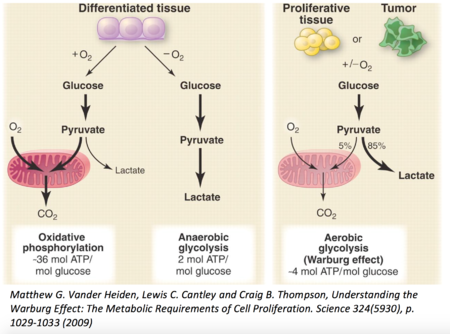Karavyraki 2017 MiPschool Obergurgl: Difference between revisions
No edit summary |
No edit summary |
||
| (2 intermediate revisions by 2 users not shown) | |||
| Line 1: | Line 1: | ||
{{Abstract | {{Abstract | ||
|title=[[File:KaravyrakiMarilena.jpg|left|90px]] Mitochondrial function and morphology linked to metabolic differences in normal, dysplastic and cancerous oral cells. | |title=[[File:KaravyrakiMarilena.jpg|left|90px]] Mitochondrial function and morphology linked to metabolic differences in normal, dysplastic and cancerous oral cells. | ||
|info=[[ | |info=[[MitoEAGLE]] | ||
|authors=Karavyraki | |authors=Karavyraki M, Porter RK | ||
|year=2017 | |year=2017 | ||
|event=MiPschool Obergurgl 2017 | |event=MiPschool Obergurgl 2017 | ||
|abstract=[[Image:MITOEAGLE-logo.jpg|left|100px|link=http://www.mitoglobal.org/index.php/MITOEAGLE|COST Action | |abstract=[[Image:MITOEAGLE-logo.jpg|left|100px|link=http://www.mitoglobal.org/index.php/MITOEAGLE|COST Action MitoEAGLE]] | ||
The aim of this project is to characterize differential mitochondrial function/morphology in comparisons of normal, dysplastic and cancerous oral cells. Oral squamous cell carcinoma (OSCC) is the sixth most common cancer in the world and accounts for more than 90% of oral malignancies. OSCC is usually preceded by the oral premalignant lesions, mainly oral leukoplakia (OLK) after repeated insults of carcinogens, tobacco[1]. We are currently comparing the bioenergetics profiles of dysplastic oral keratinocyte (DOK) cells with immortal squamous cell carcinoma 4 (SCC4) cells, both derived from human tongue. | |||
Using intact cells in an Agilent Seahorse Flux XF-3 Analyzer, we have been able to demonstrate that DOK (4616±4 nmol O<sub>2</sub>/min/106 cells) and SCC4 (4389±23 nmol O<sub>2</sub>/min/106 cells) cells have demonstrable oxygen consumption rates. Furthermore, by addition of a combination of rotenone and antimycin A, we have been able to demonstrate that 77% OCR is due to oxidative phosphorylation in SCC4 cells. Mitochondrial oxygen consumption in both cell types is inhibited by oligomycin. However, uncouplers carbonyl cyanide-p-trifluoromethoxyphenyl-hydrazone (FCCP), carbonyl cyanide m-chlorophenyl hydrazine (CCCP) and 2,4 dinitrophenol appear to inhibit oxygen consumption in SCC4 cells. It is also noteworthy that neither gramicidin D nor veratridine increased oxygen consumption in SCC4 cells. | |||
Future work will entail characterising the bioenergetic profile of intact and permeabilized DOK and SCC4 cells in suspension using Oroboros high-resolution respirometry. Bioenergetics differences will be correlated with morphological changes in mitochondria, while NMR metabolite analysis will be used to investigate their metabolite profile. Furthermore cells will be characterised for invasiveness, migration, anoikis resistance and hypoxia. | |||
|editor=[[Kandolf G]] | |||
|mipnetlab=IE Dublin Porter RK | |||
}} | }} | ||
{{Labeling | {{Labeling | ||
|event= | |area=Respiration | ||
|diseases=Cancer | |||
|organism=Human | |||
|preparations=Intact cells | |||
|couplingstates=LEAK | |||
|pathways=ROX | |||
|instruments=Oxygraph-2k | |||
|event=B1 | |||
}} | }} | ||
== Affiliations == | |||
::::School Biochem Immunol, Trinity Biomed Sci Inst (TBSI), Trinity College Dublin, Ireland. – karavyrm@tcd.ie | |||
== Figure 1 == | |||
[[File:Karavyraki_Figure_IOC122.png|left|450px |Figure 1]] | |||
== References and support == | |||
::::#Dong Y, Zhao Q, Ma X, Ma G, Liu C, Chen Z, Yu L, Liu X, Zhang Y, Shao S, Xiao J, Li J, Zhang W, Fu M, Dong L, Yang X, Guo X, Xue L, Fang F, Zhan Q, Zhang L (2015) Establishment of a new OSCC: cell line derived from OKL and identification of malignant transformation-related proteins by differential proteomics approach. Sci Rep 5:12668. | |||
:::::'''Selected mentor:''' [[Porter RK | Prof. Richard K. Porter]] | |||
Latest revision as of 05:00, 18 March 2019
| [[Has title:: Mitochondrial function and morphology linked to metabolic differences in normal, dysplastic and cancerous oral cells.]] |
Link: MitoEAGLE
Was written by::Karavyraki M, Was written by::Porter RK (Was submitted in year::2017)
Event: Was submitted to event::MiPschool Obergurgl 2017
[[has abstract::
The aim of this project is to characterize differential mitochondrial function/morphology in comparisons of normal, dysplastic and cancerous oral cells. Oral squamous cell carcinoma (OSCC) is the sixth most common cancer in the world and accounts for more than 90% of oral malignancies. OSCC is usually preceded by the oral premalignant lesions, mainly oral leukoplakia (OLK) after repeated insults of carcinogens, tobacco[1]. We are currently comparing the bioenergetics profiles of dysplastic oral keratinocyte (DOK) cells with immortal squamous cell carcinoma 4 (SCC4) cells, both derived from human tongue.
Using intact cells in an Agilent Seahorse Flux XF-3 Analyzer, we have been able to demonstrate that DOK (4616±4 nmol O2/min/106 cells) and SCC4 (4389±23 nmol O2/min/106 cells) cells have demonstrable oxygen consumption rates. Furthermore, by addition of a combination of rotenone and antimycin A, we have been able to demonstrate that 77% OCR is due to oxidative phosphorylation in SCC4 cells. Mitochondrial oxygen consumption in both cell types is inhibited by oligomycin. However, uncouplers carbonyl cyanide-p-trifluoromethoxyphenyl-hydrazone (FCCP), carbonyl cyanide m-chlorophenyl hydrazine (CCCP) and 2,4 dinitrophenol appear to inhibit oxygen consumption in SCC4 cells. It is also noteworthy that neither gramicidin D nor veratridine increased oxygen consumption in SCC4 cells.
Future work will entail characterising the bioenergetic profile of intact and permeabilized DOK and SCC4 cells in suspension using Oroboros high-resolution respirometry. Bioenergetics differences will be correlated with morphological changes in mitochondria, while NMR metabolite analysis will be used to investigate their metabolite profile. Furthermore cells will be characterised for invasiveness, migration, anoikis resistance and hypoxia.]]
• Bioblast editor: [[has editor::Kandolf G]]
• O2k-Network Lab: Was published by MiPNetLab::IE Dublin Porter RK
Labels: MiParea: MiP area::Respiration Pathology: Diseases::Cancer
Organism: Organism::Human
Preparation: Preparation::Intact cells
Coupling state: Coupling states::LEAK
Pathway: Pathways::ROX
HRR: Instrument and method::Oxygraph-2k
Event: Event::B1
Affiliations
- School Biochem Immunol, Trinity Biomed Sci Inst (TBSI), Trinity College Dublin, Ireland. – karavyrm@tcd.ie
Figure 1
References and support
- Dong Y, Zhao Q, Ma X, Ma G, Liu C, Chen Z, Yu L, Liu X, Zhang Y, Shao S, Xiao J, Li J, Zhang W, Fu M, Dong L, Yang X, Guo X, Xue L, Fang F, Zhan Q, Zhang L (2015) Establishment of a new OSCC: cell line derived from OKL and identification of malignant transformation-related proteins by differential proteomics approach. Sci Rep 5:12668.
- Selected mentor: Prof. Richard K. Porter


